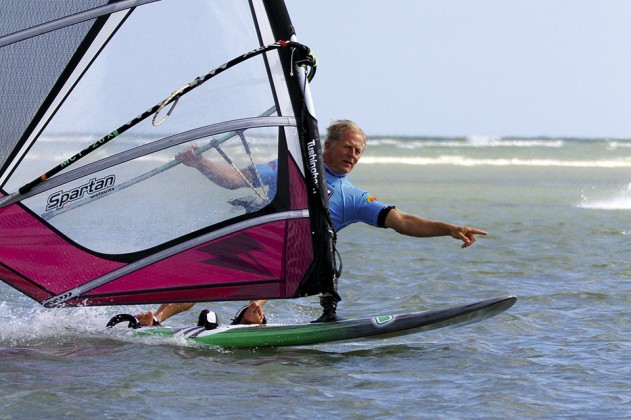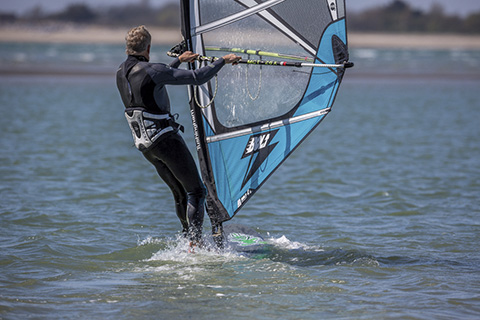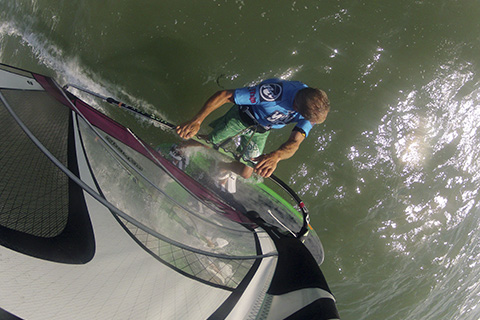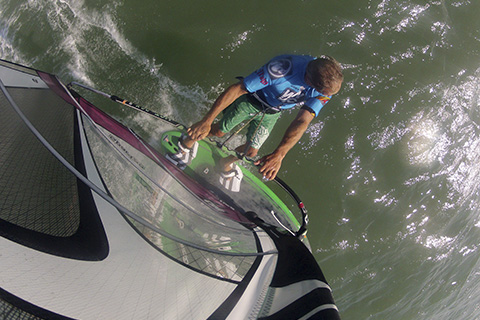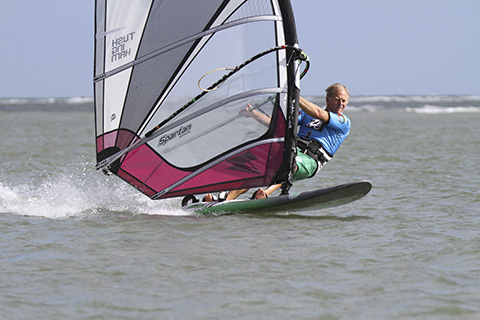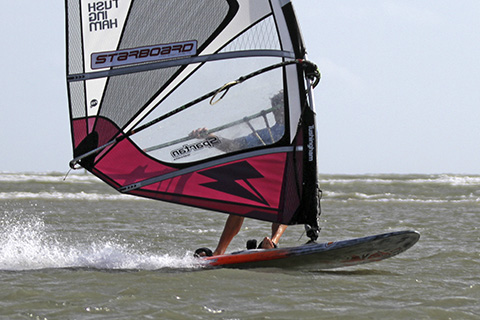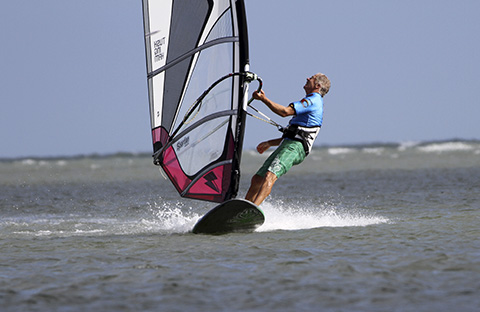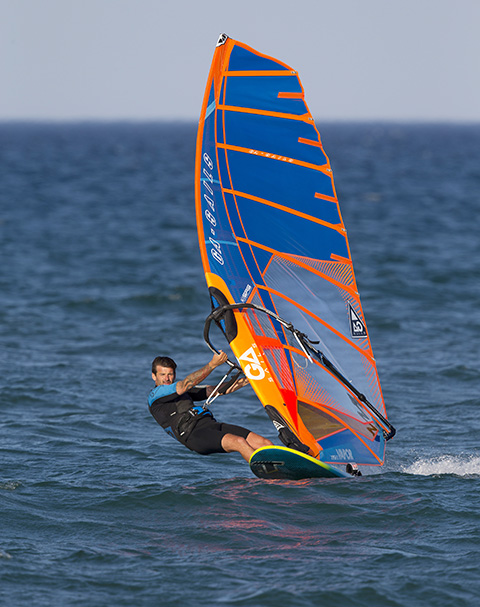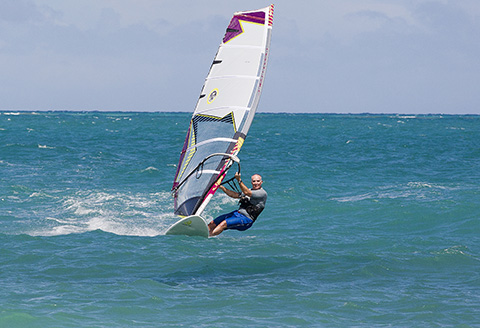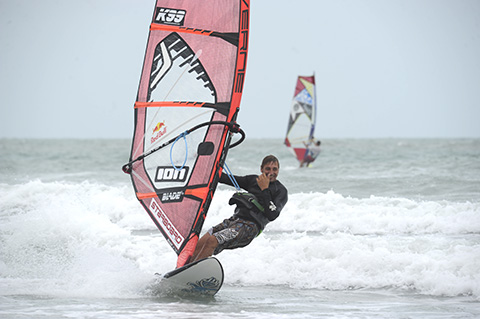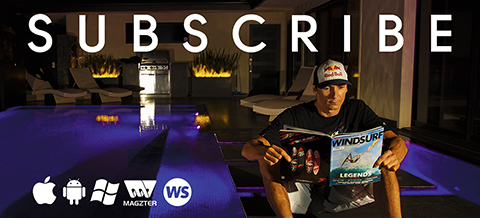THE UPHILL BATTLE
Words Peter Hart // Photos Hart Photography
Whether you’re an apprentice planer, pubescent wave-sailor or aspiring racer, the ability to cruise nonchalantly upwind should be at the top of your ‘to master’ list. Peter Hart has tips, techniques and strategies for all occasions.
I couldn’t have been more pumped up if I’d been on a diet of raw meat and steroids and been left connected to an air hose all night. The occasion was the SW Funboard Cup in Cornwall – a major event with a hefty purse attracting a horde of European stars. It was my first proper wave contest and in round one I’d drawn the recently crowned Olympic champion, Stefan van den Berg. Thirty knots of side-shore autumn breeze were whipping the tops off a meaty Gwithian swell. Conditions were perfect for an upset. Stefan may have been a global star but while he’d been trickling around the buoys of Los Angeles on a 4m Windglider. I had spent big chunks of the year in the West Country trashing wave kit.
The hooter sounded. Off we launched. We hit the same wave and while I got a soaring three foot, ‘tip dip’ jump, he was taken down by the white water and had to swim. Yesssssssss! It was in the bag. I gybed onto a decent swell, kicked off downwind and did at least 3 wiggle turns (don’t expect too much – this was 1985). I couldn’t even see Stefan – he was probably still swimming. I repeated the circuit two more times before coming in, surely to be mobbed by an army of partisan admirers for scoring a famous underdog victory. There was no one. Crowds, fellow competitors and judges had apparently gone home. Except they hadn’t. As I scoured the upwind horizon I could just make out dots on the beach and a judging tower. I wasn’t just downwind, I was in another county. For those familiar with the area, I had started at Gwithian and had beached just upwind of Red River = well over half a mile. After I’d caught a bus back to the competition site, the judges revealed that despite their top-of-the-range binoculars, they’d lost sight of me after my first ride. Stefan, on the other hand, after his momentary upset, used the devilishly cunning strategy of staying in front of them where they could … judge. By the way, I lost.
THE DOWNWIND DEBT
The salutary lesson from that fateful day was that upwind sailing is a crucial part of all disciplines, competitive and non-competitive. In and out of waves, the most exhilarating pursuits – the soaring jumps, the down-the-line rides, the screaming broad reaches, even getting planing – they all involve bearing away. Every time you sail downwind, you have an upwind debt to pay. The quicker you can foot the bill, the more fun you have. During my wave heat I was like a student with his first credit card – spend, spend, spend but with no real concept of how or when I was going to pay it all back – never as it turned out.
Continually struggling to stay upwind is like having a badly paid job, which you hate and which you’re not very good at. It’s a load of miserable effort just to get nowhere.
UPWIND SAILING – THE NATURAL BAROMETER
It’s not over-stating the point to say that you can gauge someone’s overall competence in a given situation by how easily they stay upwind. If they’re holding station effortlessly you know that:
• they’re making most of their tacks and gybes or at least are waterstarting quickly.
• they know where the wind is and which point of sailing they’re on.
• they are reading the conditions, clocking the wind shifts, exploiting the wind bends and currents and using the waves to their advantage.
• they have cute rig and board power control. Upwind is where the rig provides the least forward force so they have to trim board and sail finely in order to make use of every drop.
• they can make tweaks to the set-up to produce the right kind of power and the right stance for different conditions.
During my wave heat I was like a student with his first credit card – spend, spend, spend but with no real concept of how or when I was going to pay it all back – never as it turned out.
The major advantage of improving your general upwind skill is that you end up on the kit that you want to be on to do whatever it is you really want to do – and not be forced onto the over-sized barge with the beast of a fin that you need to save you from the nearest lee shore.
Upwind competence breeds belief and a positive attitude to the session.
The confident pointer, be it a top wave sailor or amateur free-rider, exploits the whole area, is happy to bear away below his launch point and sails with literal and mental freedom.
Those who struggle to stay upwind, sail as if they have a two pence piece clenched between their buttocks. They’re tense, nervous, continually trying to point the nose higher than it’s able to go and squeak back to their start point. It’s this constant low-level angst that wrenches the spring from their step and the adventure from their hearts.
TECHNIQUE THEN TACTICS
Upwind sailing is a mission in two parts. It’s only when you start to relax in your upwind stance, that you can lift your head and really take in the surroundings and get tactical.
So the first of the challenges is purely technical. It’s the skill of getting your chosen kit to sail higher than a beam reach. But before that, we shall look quickly at the crucial topic of upwind wastage.
// So many waste their upwind yards by just dribbling downwind off the plane. Lulls are an opportunity to GAIN yards by standing forward and outboard, pushing in the windward edge with the heels so it acts like a dagger, and then stuffing the board upwind until you find a gust to bear away into. Photo Dave White
DON’T WASTE IT!
I’m on the beach at Kilcummin in Kerry. There’s 20-25 knots of side shore wind, a head high swell and lots of white water. Ryan is rigged, booted and ready. He walks to the water’s edge. He launches, bears away to try to plane. Gets out, turns round, and comes back in. He hasn’t really done anything and yet and I have to walk 400m downwind to meet him. What is going on?
Adding some details to that story – as he walked to the water he yielded to the wind and walked diagonally downwind to the water. There’s 50 metres lost and he hasn’t even sailed yet.
He dropped the board in about knee-deep water, adjusted a harness line and then ‘faffed’ about for ages trying to beachstart. The retreating white water produced a downwind rip, which caught the fin and dragged the tail downwind. He kept walking downwind trying to catch it up and get on – another 100m lost.
He bore away to get planing. It didn’t happen, not enough power. But rather than head up again, he just kept on sailing out of the straps about 20º off the wind. Say goodbye to another 100m.
Some way out and still off the plane, he tried to tack, fell in and took about 10 min to waterstart = 50m of downwind drift.
Coming back in, he kept bearing away to catch waves but rather than head up between them, he stayed on a broad reach all the way to the beach – another 100m lost.
// It’s not too bad but basically he’s just standing over the tail half sheeted in. Photo Hart Photography
// But here the hips are high and forward. He’s committed to the harness and actively driving power into the mast foot. Photo Hart Photography
DON’T STALL!
Losing drive, crabbing sideways, dying on the tail all come under the common heading of ‘stalling.’ It’s the most popular way of NOT going upwind and is invariably down to overloading the tail and the fin by trying to sail too close to the wind too slowly. That in turn may be down to a dodgy stance and even dodgier board and sail trim. The mast shot reveals the difference (I hope you CAN tell the difference?). In the good example the hips are high, the arms are extended, he’s committed to the harness and the hook is lined up with the front foot, which means he’s driving forward and not overloading the fin. In the not so good shot, the wake washing over the windward edge is not a good sign. The hips are low and back. Bent arms show he’s lost commitment. Rather than driving the board, he’s just standing on the tail.
The four basic lessons to be gleaned from that are:
Walk Upwind! Put some money in the bank. Yes it takes a bit more effort but walk upwind as you head to the water so you begin ahead of the game.
Beachstart – drop and go. If you need to adjust footstraps, harness lines etc, do it on the dry shore in the knowledge that as soon as you drop kit in the water, waves or no waves, the kit will drift downwind.
Then when you do launch the board, give yourself 2 seconds to get on. Unless the wind has suddenly dropped, there is no reason to delay. If you do get knocked out of shape, don’t keep chasing the tail downwind but pick the board up, hold your ground, wait for the right moment and then go again. Even as you’re waiting, holding the kit, keep shuffling upwind.
Bear Away … but then don’t keep dribbling off wind. Bearing away to get planing is absolutely the right thing to do and not enough people do it … enough. But what bumps you up onto the plane is the surge of power you generate from suddenly changing angle from tight to broad reach. If you don’t plane immediately, staying off the wind doesn’t help because you’ve lost that surge of power. If you don’t plane within a few seconds of bearing away, head back up onto a close reach and wait for the next gust to bear away into. The top tip is to use all off-the-plane time to stuff the board upwind.
I’m at risk of over-egging this already stodgy pudding, but ending up downwind is the most common cause of angst and angst is the greatest learning inhibitor.
Waterstart OR uphaul. Ryan was on a 115 ltr board. During the 10 minutes he sat in the ‘not-quite-waterstarting-downwind-drift’ position, he didn’t once abandon the mission and try to uphaul. Yes it was choppy but it was worth a go – and in a quieter moment, it’s absolutely a skill worth practising and nailing. Winning the upwind battle comes first of all from adopting an urgent mind-set. To do nothing, i.e. to be swimming around NOT sailing, is to
lose ground.
SAILING UPWIND – TECHNICAL AND PHYSICAL
Sailing a board close to the wind is all about … wait for it …feel. Yes I know – that’s really annoying. What you crave is good, solid, “do this and that will happen” type advice. Well there are templates for upwind stances, which will be described – but the skill lies in constant adjustment of the board’s angle to the wind, of your fore/aft body position; of the pressure against the fin or rail; of the shift between front and back foot; of the windward leeward board angle, so you deliver the right balance of pressure and power to keep it tracking straight.
The first concept to grasp is that whilst on the one hand it is a technical balancing act, on the other, it’s also more physical and proactive.
When you’re setting out on your planing career, it’s natural to head off wind because it feels easy. Between a beam and a broad reach the sail produces the maximum forward force. As you accelerate, you catch the wind up, and the rig lightens up. You generally have a bit of reserve power so you can be a little reticent, a bit sheeted out, not totally committed to the harness and still get blown along like a paper boat.
But as you turn upwind, you are literally battling against the elements. Those forward forces decrease and give way to stronger lateral ones which you have to resist and actively redirect. Grit the teeth and lets get physical …but in a touchy-feely way.
The basic difference is that off the wind you get blown along but upwind YOU have to drive the board forward.
What’s happening?
On all points of sailing, planing is a power-sharing act between your feet and mastfoot to keep the board riding level nose to tail. As you head up from beam reach to close reach, riding fast and straight is a greater challenge because:
1. The MFP drops. The sail produces less forward drive, meaning there’s less mastfoot pressure, meaning that if you do nothing, the nose will rise, you’ll stall on the tail and drop off the plane.
2. There’s more sideways force. As you steer upwind, the rig wants to drive the board sideways. So you need to direct its force in such a way that the fin (or the daggerboard) or the edges of the board can best resist it and turn it into forward speed.
Your whole stance and trim is largely governed by your chosen kit. Is it speed or manoeuvre oriented? How much power are you carrying and what do have at your disposal to resist it? Let’s look at the options.
The Upwind Stance Template – fin or rail
There are two distinct planing upwind techniques. One is the classic racing, slalom, free-ride, speed/power oriented stance.
The other is freestyle/wave-sailing technique based around a manoeuvre-oriented set-up.
// The big free-ride board is sailed flatter, higher and more off the fin. Photo Simon Bassett
// The freestyle wave board is sailed faster, lower and more on the windward edge. Photo Simon Bassett
LESS FIN, MORE RAIL
The pics look very similar but in fact one is a 120 litre Free-ride board with a 48cm fin powered by a 7.5 sail; and the other a 100 litre freestyle wave with a 22cm freestyle fin and a 5.5 sq m sail. The devil lies in the detail. On the bigger kit, it’s all about exploiting that power from the fin with heels driving right against the apex of the rail; then angling the rig back, keeping the board level and really driving the hips forward. On the smaller board, the straps are inboard so the back foot has pulled out slightly to make a more comfortable contact with the rail. The rig is more upright over the front foot so the rig doesn’t overpower the fin; the windward edge is engaged for extra grip and the board is being sailed faster and about 10º more off wind.
The upwind SPEED stance
It’s about taking the grunt from a powerful sail and directing it into an equally big and powerful upright fin (were it only so simple…).
The classic powered up stance is rig back, hips and head forward.
As you steer upwind and feel the forward pull drop, ease the hips forward, feel the front of the harness load up and actively drive the power and your bodyweight into the mastfoot. At the same time the lion’s share of power transfers to the back foot.
It is primarily a back foot stance. But how hard you push on the fin, if at all … that’s the ‘feel’ bit and depends how fast you’re going and the size of that fin.
Railing. A crucial aspect of this stance is the leeward/windward trim angle. As you head onto your close reach think first of all about running a flat board. But then with the feet in outboard straps, dip toes and lift heels to experiment with that angle. Like a dinghy, some boards like to ‘rail’ a little and ride best with the windward edge slightly up. The fin has a better angle of attack and the leeward edge bites for extra resistance. In truth what feels like ‘windward edge up’ is actually flat. If you depress the windward rail the big fin stops lifting and the board tends to tilt off wind.
Under-powered – over-powered.
With free-ride kit you generally aim to be powered up. When you are, the sail still provides a lot of forward grunt so you don’t have to adjust your body position too much to go upwind. Just sail between the feet.
Looking at a still of a powered up racer at full tilt, it’s hard to tell from their body angle what point of sail they’re on.
But as the wind drops, that’s where fine skill is required. As you slow down, the fin produces less lift. If you keep pushing against it with the same gusto, you’ll drive it through the water and stall. The first measure is to bear away a little to increase speed and let the rig pull you forwards and inboard; and take pressure off the tail.
Under-powered the back foot can feel too far back and too far outboard, so you can restore trim and comfort by moving it inboard and forward of the strap and sail with more equal weighting on both feet.
// Lifting the hips and dropping the toes and getting the windward edge to lift on a freeride board – if you find just the right angle, suddenly you can shoot upwind like on rails – or you can spin out horribly. But you won’t know until you try. Photo Simon Bassett
EXPERIMENTING WITH ANGLES
To achieve perfection, you have to experiment rather than sail to a formula. It’s especially true of upwind board angles. Do you know what angle your board likes to be ridden upwind? There is no one answer. It all depends on the water state, the design of board, size of fin, how powered up you are. The answer is to experiment to find that position where the board bites and tracks. If the windward edge is too high, air can get under the board and cause spin out. If the windward edge is down on some boards, the footstraps catch and the fin stops working.
THE UPWIND STANCE – FREESTYLE AND WAVE BOARDS
You’re set up to manoeuvre. Wave and freestyle sails have a flat profile and don’t produce so much sideways force, which is just as well as tiny freestyle fins and wave fins offer minimal resistance and lift – their role is to add a little directional stability and, in the case of the latter, drive through banked turns.
The trick to getting upwind on these boards is to pretend you haven’t got a fin. The tail is a no go zone for weight or pressure. Hold the rig upright (don’t rake it back) and think of sailing 100% off the front heel. Use that front feel to depress the WINDWARD edge, which is your one source of resistance.
Speed is absolutely your friend on this kit, so don’t try and stuff it up too much but sail fast and low. When you do get up to full speed, the fin will offer a little bite, but still be gentle with it.
On big free-ride kit, it’s rig back, hips forward, back foot pressure with the windward edge UP. On freestyle or wave kit, it’s rig forward, FRONT FOOT pressure, windward edge DOWN.
THE UPWIND JOURNEY
I recommend learning upwind sailing with a daggerboard. Not much gets past it, however unsubtle you are. It is a bit of a blunt instrument but gets over (sometimes quite spectacularly) the concept that the foil doesn’t just resist the rig but also fights back and actually lifts the board up; and that the amount of lift depends how fast you’re going and how much force you direct against it. You then have to react to that lift, adjust your position and the amount of pressure through your feet (and especially the back foot) to hold the trim (and in the case of a BIG dagger, stop you capsizing).
Long board racers very quickly learn to adapt their style to sail small kit upwind because they’ve become especially good at generating and balancing lift.
From a dagger you move to a free-ride board and a big fin. The advantage of the big fin is that you feel its resistance and lift at slow speeds. When you’re starting out, you tend to sail more slowly and are very grateful for those lower gears.
Fin size is something of a litmus test, in that the better you get and the faster you sail, the smaller the fin you can use. (It’s only true up to a certain point in that every freeride board needs a minimum size fin to make it work at all, no matter how fast you’re going.)
// Roscoe – an upwind master.
POWERING UPWIND WITH ROSCOE
Ross Williams, as you might expect from the Formula World Champion, is pretty cute at making any board go upwind. Here’s what he has to say:
“The key to staying upwind on regular gear is to have fin pressure to fly the board and get angle. If you are under-powered, try making your harness lines shorter, lift your boom and stay light on your feet. Don’t push too hard from the side, more from the top, on your toes. If your planing easy, and have enough power, then just use your head and look where you want to point and you will find that will change your body angle enough to direct your equipment.”
THE PROBLEM PAGE
No technique article would be complete without a look at the common failings. In upwind sailing, such failings are many and various. Here are the most common, which may have their roots in a dodgy set-up or a dodgy pilot.
Continually stalling…
Stalling describes the moment when smooth flow is disrupted. It’s when the nose is pointing upwind, but you’re actually slipping gradually sideways in a continuous 4 wheel skid, accompanied by lots of gurgling and sucking noises.. In extreme cases you lose the tail altogether and spin out. Basically the sideways forces are over-powering the resistance. Here, in order of likelihood, are the reasons – starting with pilot error.
Sailing too close to the wind.
Foot off a few degrees and release the board.
There – that was easy.
The free-ride upwind technique is similar to angling the rig back and driving through the boom to push the board forward through the shallows prior to a beach start.
Sailing too slowly.
A real problem if you’re on a small fin. Small fins need a fast water flow to make them work. The fastest I’ve ever sailed upwind was on a 38 cm wide speed board with a 20cm fin – but it was on flat water and I was doing about 30 knots.
Sailing upwind on all kit is about finding the right balance between speed and height. On kit with big lift devices you’ll tend to sail higher and slower. On small kit you’ll need to sail lower and faster.
// Downwind Dave having the time of his life in St Lucia. Making a name change to ‘Upwind Dave’ will come from lifting the hips, keeping the rig more upright and NOT relying so much on the fin for drive. Photo John Carter
SIZING UP
By far the most common reason for ending up constantly downwind is being under-powered on too small kit. I hate to defame my own race but it’s usually big blokes. Big blokes love to be powered and love even more that feeling of driving harder and harder against a powerful fin to get more and more lift. The problem is they grow over-reliant on the fin and the support of the sail. When the wind drops, rather than come inboard, stand upright, bear away a little and release those pressures, they stay committed and stall. ‘Downwind Dave’, a good friend of JC is one such bloke who loves his windsurfing but didn’t get his nickname for nothing. He’s a big bloke. In the pic below he’s looking dandy and actually staying upwind but from the windward rake of the mast and the depressed windward edge, you can see he’s over-committed. Staying upwind in the lulls will come from sailing more on the toes.
// Skippy, easing upwind, windward edge down on his twinser. Photo Adrian Irvine
UPWIND WITHOUT A FIN – WITH SKIPPY
Colin ‘Whippy’ / ‘Skippy’ Dixon, although pretty tasty on slalom kit, is of that generation which grew up with freestyle. From day one therefore he learned to go upwind without a fin. Heed these tips. “It’s all about sailing on the front foot, LOOKING where you want to go with your HEAD not your EYES, don’t be scared to turn you head and look over your shoulder. It’s a good habit to get into as that’s where the wind and waves are coming from. Also with wave and freestyle boards you normally have big straps. Don’t be scared to bring your feet out of the straps a little so you can get your weight onto the rail. I always lift up my big toe on my front foot and roll to the out side of my foot and bend my knee forward and upwind a little. And bring the back foot out of the strap a little and point your heel forward and towards the front of the board. This will bring your body weight forward and take a lot of pressure off the fin to stop that spin. And just remember, we are using the rail to get you upwind, not the fin so much!”
Too much lateral foot pressure.
The angle your heels make contact with the board determines how much sideways pressure you exert on the fin. Any aspect of your set-up that drops your hips and leaves your legs parallel to the water, namely a low boom and/or very long lines, aggravates the stalling problem. As they approach the upwind leg, racers often shorten their lines to lift the hips and bring their weight more over the board; which also encourages the windward edge to lift. Using a small fin, therefore, it’s key to keep the hips high with a relatively high boom so your feet press down on the rail not straight against the fin.
Always sailing big kit can make you over-reliant on the fin. For many, it’s their first port of call when they want to get planing or stay upwind. Give it a hoof and, like a ‘torquey’ diesel engine, it grinds them upwind.
Over-sheeting.
I wish I had means to highlight this paragraph with a pyrotechnic display because this is the COMMONEST mistake of all. As you try to climb higher instinctively you may pull in harder on the back hand to power up. If you need to pinch up a round a mark, and if you have a monster fin or dagger, it can work. However under normal circumstances, if you over-sheet, you increase the lateral pull in the sail and over-power the fin even more. In a gust especially, the best way to climb higher is to twist the hips towards the nose and ‘feather’ the sail (depower slightly). As the sails feathers, the effort moves back a little and drives you upwind. Harness Line Position is crucial in this regard. If they’re too far back, you can’t sheet out. If you’re always sheeted right in, the effort stays forward and wants to bear you away.
Always losing ground – never get a feeling of pointing. As soon as you head upwind you stop.
It sounds primarily like too much rig for the board and fin. (Perhaps you took those recommended sail sizes literally, went for the biggest but didn’t up the fin size?) For efficient pointing on freeride kit, you have to feel the board coming up on the fin and properly releasing. If instead the board sits in the water and you feel the tail constantly twitching, you need more fin. The general message is that loading up with more power is the way to point – but only if that power is matched by the fin. That’s why loading a wave board up with a monster rig is doomed to failure because neither the fin nor the soft rails can take it.

